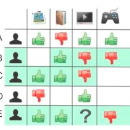Collaborative filtering (CF) plays a critical role in the development of recommender systems. Most CF methods utilize an encoder to embed users and items into the same representation space, and the Bayesian personalized ranking (BPR) loss is usually adopted as the objective function to learn informative encoders. Existing studies mainly focus on designing more powerful encoders (e.g., graph neural network) to learn better representations. However, few efforts have been devoted to investigating the desired properties of representations in CF, which is important to understand the rationale of existing CF methods and design new learning objectives. In this paper, we measure the representation quality in CF from the perspective of alignment and uniformity on the hypersphere. We first theoretically reveal the connection between the BPR loss and these two properties. Then, we empirically analyze the learning dynamics of typical CF methods in terms of quantified alignment and uniformity, which shows that better alignment or uniformity both contribute to higher recommendation performance. Based on the analyses results, a learning objective that directly optimizes these two properties is proposed, named DirectAU. We conduct extensive experiments on three public datasets, and the proposed learning framework with a simple matrix factorization model leads to significant performance improvements compared to state-of-the-art CF methods. Our implementations are publicly available at https://github.com/THUwangcy/DirectAU.
翻译:合作过滤(CF)在开发建议系统方面发挥着关键作用。大多数CF方法都使用编码器将用户和项目嵌入同一代表空间,而巴伊西亚个性化排名(BPR)损失通常被作为学习信息编码器的客观功能。现有研究主要侧重于设计更强大的编码器(如图形神经网络),以更好地进行表述;然而,很少专门致力于调查CF代表的预期属性,这对于理解现有CF方法的理由和设计新的学习目标十分重要。在本文中,我们从超镜的校准和统一的角度衡量CFC代表质量。我们首先从理论上揭示BPR损失与这两个属性之间的联系。然后,我们从量化的校准和统一的角度对典型CFC方法的学习动态进行了实证分析,这表明更好的校准或统一有助于更高的建议性表现。根据分析结果,一个直接优化这两种属性的学习目标被提出来。我们从三种公共数据设置的校准/CFFM的模型上进行了广泛的实验,与我们现有的公共数据库/CFFM的学习框架相比,一个简单的业绩模型是我们现有的标准。



